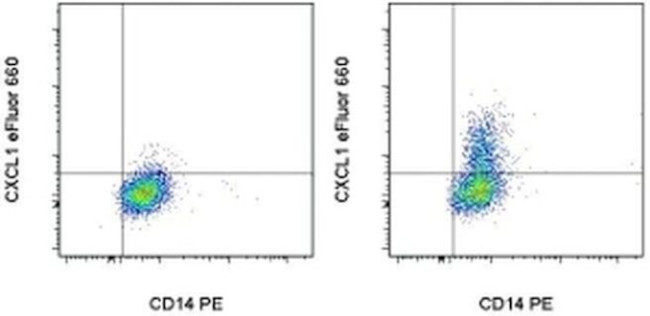Search Thermo Fisher Scientific
Invitrogen
CXCL1 (GRO alpha) Monoclonal Antibody (KTYFLF), eFluor™ 660, eBioscience™
FIGURE: 1 / 2
CXCL1 (GRO alpha) Antibody (50-7515-42) in Flow


Product Details
50-7515-42
Species Reactivity
Published species
Host/Isotype
Recommended Isotype Control
Class
Type
Clone
Conjugate
Excitation/Emission Max
Form
Concentration
Purification
Storage buffer
Contains
Storage conditions
Shipping conditions
RRID
Product Specific Information
Description: This KTYFLF monoclonal antibody reacts with human CXCL1 and has no cross-reactivity to human CXCL2 or CXCL3. CXCL1, or GRO (growth-related oncogene) alpha, is a pro-inflammatory CXC chemokine first identified by its constitutive overexpression in some tumors. It is closely related to CXCL2 (GRO beta) and CXCL3 (GRO gamma), with which it shares 90% and 86% sequence homology, respectively. These proteins, along with IL-8 or CXCL8, were later found to be critical for neutrophil mobilization and degranulation, as well as vascular permeabilization and angiogenesis. Signaling occurs through the G protein-coupled receptor CXCR2, which is shared with GRO beta and gamma. CXCR2 can also be activated by IL-8, although some studies suggest that the majority of IL-8 activity on neutrophils is mediated by CXCR1.
CXCL1 is secreted by monocytes, epithelial cells, and fibroblasts in response to pro-inflammatory stimuli such as LPS, IL-1 beta, and TNF alpha. Overexpression is observed in many malignant tumors, where it contributes to tumor vascularization and metastasis.
Applications Reported: This KTYFLF antibody has been reported for use in intracellular staining followed by flow cytometric analysis.
Applications Tested: This KTYFLF antibody has been pre-titrated and tested by intracellular staining followed by flow cytometric analysis of peripheral blood monocytes. This can be used at 5 µL (0.125 µg) per test. A test is defined as the amount (µg) of antibody that will stain a cell sample in a final volume of 100 µL. Cell number should be determined empirically but can range from 10^5 to 10^8 cells/test.
eFluor® 660 is a replacement for Alexa Fluor® 647. eFluor® 660 emits at 659 nm and is excited with the red laser (633 nm). Please make sure that your instrument is capable of detecting this fluorochome.
Excitation: 633-647 nm; Emission: 668 nm; Laser: Red Laser.
Filtration: 0.2 µm post-manufacturing filtered.
Target Information
CXCL1, CXCL2, and CXCL3, also known respectively as GRO alpha, GRO beta (MIP-2 alpha) and GRO gamma (MIP-2 beta), are members of the CXC subfamily of chemokines. Mature CXCL1/2/3 proteins bind with high affinity to the IL-8 receptor type B and are potent neutrophil attractants and activators. In vitro, the processed forms GRO-alpha(4-73), GRO-alpha(5-73) and GRO-alpha(6-73) show a 30-fold higher chemotactic activity.
For Research Use Only. Not for use in diagnostic procedures. Not for resale without express authorization.
How to use the Panel Builder
Watch the video to learn how to use the Invitrogen Flow Cytometry Panel Builder to build your next flow cytometry panel in 5 easy steps.
Bioinformatics
Protein Aliases: C Cmotif chemokine; C X C motif chemokine; C-X-C motif chemokine 1; CC motif chemokine; CCmotif chemokine; chemokine (C-X-C motif) ligand 1 (melanoma growth stimulating activity, alpha); CXC; CXC motif chemokine; CXCL; CXCL-1; fibroblast secretory protein; GRO a; GRO α; GRO-alpha(1-73); GRO1 oncogene (melanoma growth stimulating activity, alpha); GRO1 oncogene (melanoma growth-stimulating activity); GROalpha; Growth-regulated alpha protein; GROα; melanoma growth stimulating activity, alpha; Melanoma growth stimulatory activity; melanoma growth stimulatory activity alpha; MGSA; MGSA alpha; NAP-3; NAP3; Neutrophil-activating protein 3
Gene Aliases: CXCL1; FSP; GRO; GRO1; GROA; MGSA; MGSA-a; NAP-3; SCYB1
UniProt ID: (Human) P09341
Entrez Gene ID: (Human) 2919

Performance Guarantee
If an Invitrogen™ antibody doesn't perform as described on our website or datasheet,we'll replace the product at no cost to you, or provide you with a credit for a future purchase.*
Learn more
We're here to help
Get expert recommendations for common problems or connect directly with an on staff expert for technical assistance related to applications, equipment and general product use.
Contact tech support

